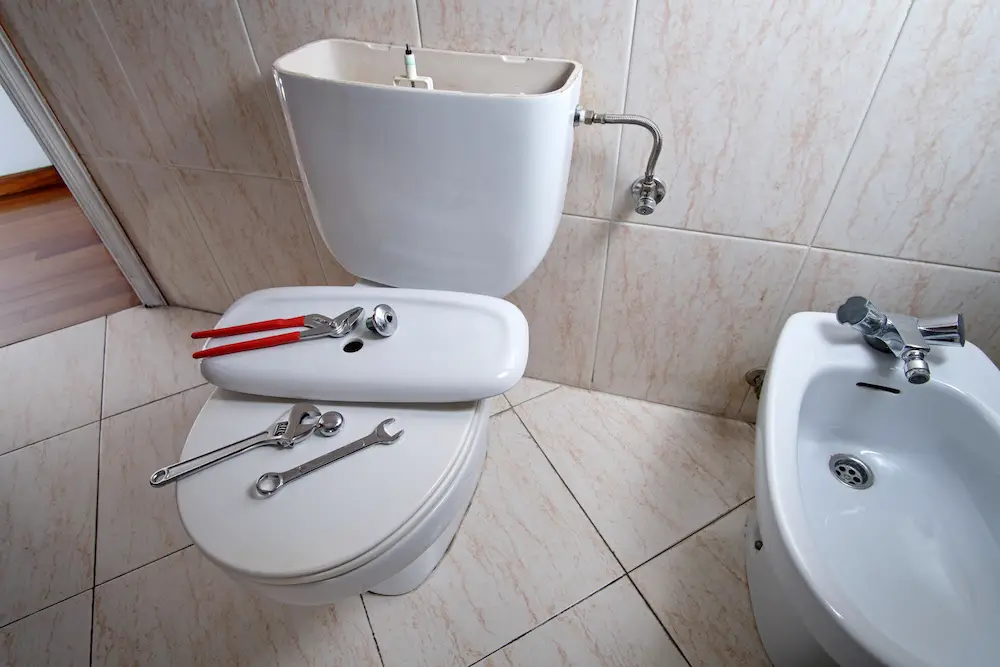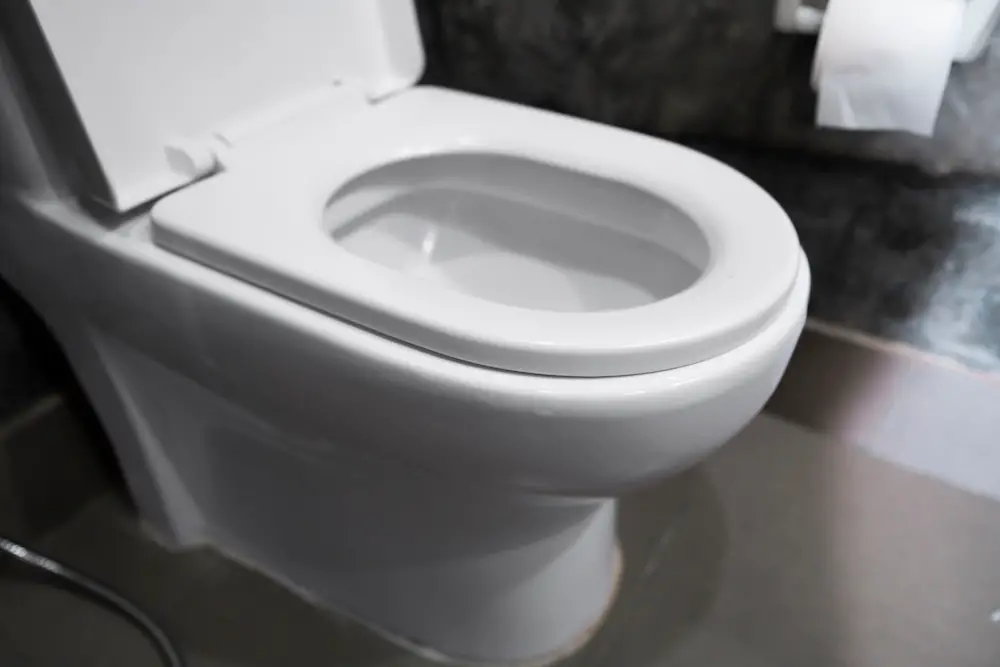A wobbly toilet can be very frustrating and uncomfortable.
Plus, it can be the root cause of serious and unpleasant problems around the bathroom.
The weight of each user bears on the fixture regularly, and its floor attachments can get dislodged or damaged over time.
When it starts to wobble, it can cause cracked drainpipes, escaping bad odors, and leaks.
Before this happens in your house, it would be beneficial to learn and understand how to fix a wobbly toilet.
It can save you a lot of money and allow you to keep using your toilet for several more years.
Things You Might Need
While the following items ensure that you have everything to repair a wobbly toilet, some of them may be unnecessary.
The exact items you will use will depend on the extent of repairs required to fix the problem.
Be ready with the proper tools, including an adjustable wrench, a putty knife, a carpenter’s level, a hacksaw, a screwdriver, a bucket, and a sponge.
Of course, you can also benefit from a pair of latex or rubber gloves if you don’t want to get your hands dirty.
Typically, the components needing a replacement include the toilet flange, the wax seal, the closet bolts, and corresponding accessories.
You can purchase standard repair kits for the flange, as you may not need to replace the entire thing.
Similarly, a foam or rubber gasket can also take the place of the wax seal.
Closet bolt accessories include lock washers for the flange, washers, nuts, and nut caps.
You might also need some plastic or wooden shims, the purpose of which we shall explain in the procedures.
Finally, you can also prepare a caulking gun and some tile caulk if you want to conceal the shims that level your toilet.
How to Fix a Wobbly Toilet
You may not notice when your toilet starts to wobble as it is a problem that can develop over time.
After an extended period of use, the wax seal, flange, or closet bolts can become defective.
In some cases, the surrounding floor settles a bit, causing the bolts and nuts to lose traction against the flange or the toilet base.
However, in the worst scenarios, wooden floorboards begin to rot due to leaks from your toilet base.
To find and apply the right fix, follow these steps:
Step 1: Checking the Bolts
When you notice your toilet wobbling, the first thing you need to check is the bolts.
Wall-hung toilets have their bolts in a horizontal position attached to the wall.
Since wall-hung toilets need more support, they will likely have more than two bolts.
Floor-mounted toilets, on the other hand, typically only have two bolts.
Some toilets keep the appearance of connections clean by concealing the bolts with caps or a skirted trapway.
You can always refer to your toilet’s accompanying documentation to find access to the bolts.
To check that the bolts are secure, kneel before the toilet and give it a nudge while looking at the bolts.
If you see movement between the bolt, washers, and the holes of the toilet base, it will need some tightening.
Try tightening the bolts with a wrench and see if it fixes the problem.
Otherwise, you might need to dismantle the toilet.

Step 2: Drain and Remove the Water
To avoid making a mess while you do the repairs, remove all water from the toilet.
First, shut off the water supply valve connected to the tank, and flush the toilet several times until the tank is empty.
You can collect the remaining water from the bottom of the bowl using the sponge and the tub.
Step 3: Dismantle the Toilet
Unscrew the nuts from the bolts to release the toilet.
Inspect the holes where the bolts cross the toilet base and look for surface damage on the ceramic.
A washer larger than the damaged area should do the trick if you find cracks or a part of the ceramic chipped off.
Otherwise, the problems must be in the wax seal, flange, or surrounding floor.
Before lifting the toilet, check if it is level by setting a carpenter’s level over the tank lid.
Doing so will tell you that something is causing the toilet to tilt on its side slightly.
If you have a one-piece toilet, lift the entire thing and set it on a stable surface.
Alternatively, you should separate the tank from the bowl if you own a two-piece toilet.
Inspect the bottom of the toilet base for any physical damage.
If a significant piece of the bottom has dislodged, it may be the root cause of the problem.
If that is the case, you might need to purchase a new toilet.
Step 4: Remove the Wax Seal
With the toilet out of the way, inspect the wax seal for deterioration.
If it has thinned too much, you will need a new wax seal or a foam gasket to take its place.
Using a putty knife, scrape the wax seal off and dispose of it properly.
Once you remove the wax seal, you can move on to inspecting the floor flange.
Step 5: Remove the Floor Flange
The Toilet flange can either be a plastic, rubber, or metal ring.
Regardless of the type, the flange can deform over time because of the weight it repeatedly bears.
Such deformation may cause the toilet to wobble.
If you need to replace the flange or a part thereof, unscrew it from the floor with a screwdriver.
Always secure a compatible replacement or repair kit.
Step 6: Make Necessary Repairs
Check whether the floor surrounding your toilet is level, rotting, or settling down.
If it is level, you just have to secure the wax seal and the flange before putting the toilet back over the drain.
Alternatively, if it has settled down a bit, you can use plastic or wooden shims to keep the toilet level even if the floor is not.
However, if the floor and subfloors near the toilet drain have begun rotting, it is a sign of a much bigger problem.
In that case, you might need to employ a contractor to fix the drainpipes, fittings, and floor.
Before reassembling the toilet, clean the drain while it is exposed so that you can extend the life of your drainage line.
Only choose the best drain cleaners for septic systems to avoid damaging the pipes.
Step 7: Reassemble the Toilet
Once you have figured out the cause of the problem and done the necessary repairs, put the toilet back in place.
Before securing the closet bolts, position the level bar on the tank lid to check if the toilet is level.
Position shims along the edge of the base as necessary until the toilet levels out.
Finally, add the washers and secure the nuts onto the bolts.
Avoid tightening the nuts too much, as doing so can damage or break the toilet base.
If you don’t like the look of exposed shims around your toilet’s base, you can conceal them by adding toilet caulk with a caulking gun.
Step 8: Check If the Problem Persists
Once everything is in place, try nudging the toilet to see if it still wobbles.
If it still does, chances are you might have missed a step.
Backtrack a bit to check where things might have gone wrong.
Successfully Fixing a Wobbly Toilet
If you know how to fix a wobbly toilet, you can save yourself from bigger problems requiring a lot of time and money.
You will only need a wrench to tighten the closet bolts in most cases, and you won’t even need to purchase any replacement parts.
Remember that if these steps did not solve your problem, it might be time to seek professional help.

